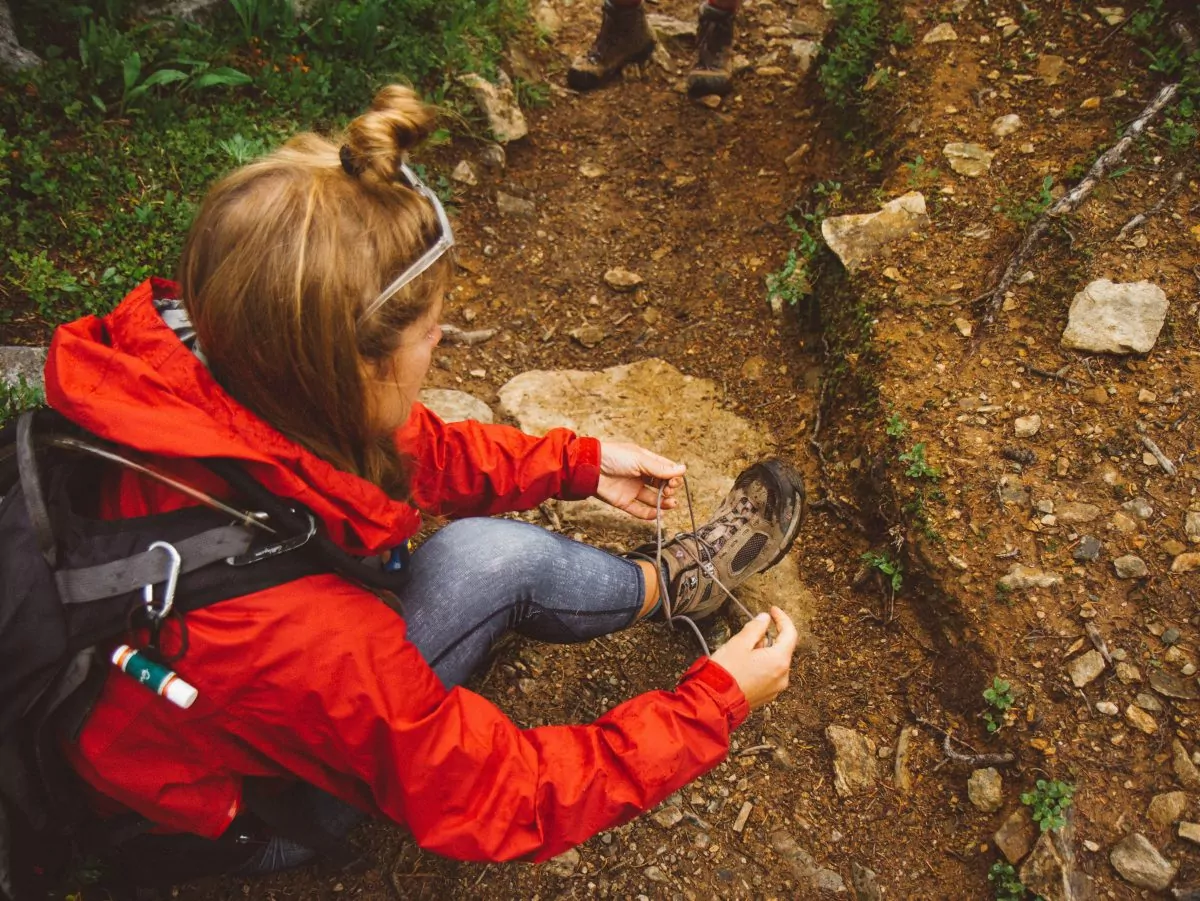How to Prevent Common Hiking Injuries

As an avid hiker, you daydream about the beautiful views, fresh air, and time to commune with nature you can only get on the trail. You plan every detail of your next adventure, down to the Caramel Almond & Sea Salt Kind bar you’ll eat mid-hike. But have you thought about preventing hiking injuries?
Hiking is generally pretty safe, but accidents happen. While most common injuries would be a mere annoyance at home or in town, they can pose big problems when you’re on the trail. If you’re in the middle of Zion National Park, the nearest CVS or urgent care is hours away.
Fortunately, you don’t have to invest in state-of-the-art equipment. A little knowledge and preparation are all you need to prevent hiking injuries. Oh, and maybe a first aid kit.
We’ve spent thousands of hours in the backcountry and seen dozens of hiking injuries. Here are a few of the most common hiking injuries, and how to prevent them.
Explore Your World with Award Winning Guides
Blisters
You may have never even thought of a blister as an injury. But tell that to your newly-raw heel as you hobble down the trail in pain.
How They Occur
Blisters occur when your skin experiences too much friction. For example, friction between your foot and your brand new pair of Oboz Yellowstone boots. When an irritant repeatedly rubs against your skin, the top layer of skin separates. A fluid-filled sac forms to protect the deeper skin layers. When blisters burst, they reveal raw skin susceptible to infection.
Prevention
Your new hiking boots look pristine but hitting the trail with brand new shoes is a recipe for disaster. Luckily, we have a simple solution. Break in your shoes!! Wear them around the house, wear them to bed, wear them while you’re running errands. Whatever you need to do, just wear them before you’re out on the trail.
As you wear them, familiarize yourself with the parts of the boot most likely to cause a blister. Then, use moleskin on areas of irritation before you hike. Moleskin is easy to find in drugstores, and you can customize it to your feet. Just cut out a piece and stick in on the area of your foot that is getting rubbed. If your body is really prone to blisters, you could use an anti-friction lubricant like Body Glide Foot Anti Blister Balm.
Sprains
Healthy ankles are crucial when you’re on a trail; they provide support and mobility so you can move easily on uneven terrain. Bruised, swollen ankles really take the fun out of your hike. And, if you suffer a bad sprain, you may need help getting back to the trailhead.
How They Occur
You can sprain many parts of your body, but the most common is the ankle sprain. A sprain results when a ligament is overstretched. (For example, when your ankle bends in an unnatural way.) On rough terrain, you can easily misstep and twist your ankle. If this happens, you can’t just “walk off” a sprain. The best remedy is rest, ice, compression, and elevation (R.I.C.E).
Prevention
To prevent spraining an ankle, strengthen your lower leg muscles and perform balance exercises. Try calf raises, yoga poses (like tree pose), and ankle circles.
When you’re on the trail, wear proper footwear for the terrain and use trekking poles to help you keep your balance. Finally, tread carefully! Slippery surfaces, jagged rocks, and uneven terrain put you at risk for sprains.
Sunburns
The sun is necessary for our survival, but sometimes it hurts the people that love it the most. Sunburns might look silly, but they are no joke. A severe sunburn can lead to blistering and flu-like symptoms like fever, chills, and aches. Prolonged sun exposure contributes to premature aging and skin cancer.
How They Happen
Because humans have spent decades indoors, many of us now lack natural protection against the sun. UVA and UVB rays land on the skin, and in response, your body produces melanin to protect you. However, when you get too much sun, your body produces an inflammatory response. The result? You look like a tomato.
Prevention
Preventing sunburn is all about creating a barrier between your skin and the sun. Sunscreen coats your skin in particles that reflect the sun’s rays. When you plan to spend all day outside, choose the right sunscreen. Many dermatologists recommend sunscreen with an SPF of at least 30. Pick a sport or waterproof formula that won’t break down when you start to sweat.
However, don’t expect to just slap some sunscreen on once a day. You’ll need to reapply every two to four hours. Or, you can opt for UV-protective clothing, like long-sleeved shirts and hats, to prevent sunburns.
Last, plan your hikes accordingly. The sun is at its strongest between 10 am and 2 pm every day. If possible, find shade or take a break during those hours.
Bug Bites
When you’re in the great outdoors, you’ll encounter a lot of bugs. Most of them won’t hurt you. Some attack mercilessly, like mosquitos, which feast on your blood with relish. While their bites aren’t dangerous, the welts they leave behind can be agonizingly itchy.
How They Happen
To mosquitoes, you look like a tasty treat. So, they bite you and suck your blood. Their saliva triggers an inflammatory response and you get a nice, itchy welt.
Prevention
Pack some bug spray. You can find many different formulas, including good old-fashioned sprays and bracelets. We’ve found that DEET products work best, but if you prefer fewer chemicals, you can use a natural repellant.
When you’re backpacking, your tent will be your sanctuary from these pesky bugs. Keep your tent door fully closed at all times, even when you’re not in it. If you’re camping in a hammock, sleep under mosquito netting. It creates a barrier between you and the bugs, allowing you to get a peaceful night’s sleep.
Hypothermia
When hiking in cold environments, preparation can be the difference between a good time and time in the hospital. Hypothermia is a life-threatening condition that occurs when your body temperature drops below 95 degrees Fahrenheit.
How it Happens
Without proper shelter or clothing, wind, rain, and snow make it almost impossible for your body to regulate its temperature. Hypothermia doesn’t only occur in snowy mountain environments; your body temperature can drop too low in cold, wet conditions, as well.
Prevention
Research the weather at your destination and bring the proper gear for the climate you’re hiking in. Bringing clothing, tents, and sleeping bags that are designed to keep you warm can save your life. If you see rain in the forecast, be sure to pack a rain jacket, rain pants, and extra socks.
Additionally, your body needs fuel to keep going in cold climates. So be sure to bring enough food!
Heatstroke
Heatstroke occurs when your body temperature rises too high. Extended sun exposure and dehydration can interfere with your internal cooling mechanisms, raising your body temperature to a life-threatening 104 degrees F.
How It Happens
The sun can do more than burn you. Without proper sun protection, clothing, or adequate water, your body becomes overwhelmed and can’t keep your core temperature at a healthy 98 degrees F . Strenuous activity (paired with high temperatures) also increases your risk of heatstroke.
Prevention
Make sure you are carrying enough water. It’s recommended that you drink one liter of water for every two hours on the trail at a minimum. You may need up to a gallon (four liters) of water in extreme climates, like the desert. If you’re hiking on a trail that has reliable water sources, bring a water filtration device.
If you feel yourself overheating, take a break to lower your heart rate. In the middle of the day (10 am to 2 pm), find shade or take a break because the sun is at its strongest. For example, we start hiking before sunrise on our Grand Canyon backpacking trips.
Finally, wear proper clothing for your hiking environment and shed layers as needed to allow for evaporative cooling.
Preventing Hiking Injuries
With a little knowledge and planning, you don’t need to let a hiking injury spoil your trek. Even better? Let an experienced guide help you on a guided day hike or backpacking trip! Guides have seen it all and will tell you if you are about to make a mistake. And when mistakes do happen guides have Wilderness First Responder training to treat your injury and keep you safe in the backcountry.




